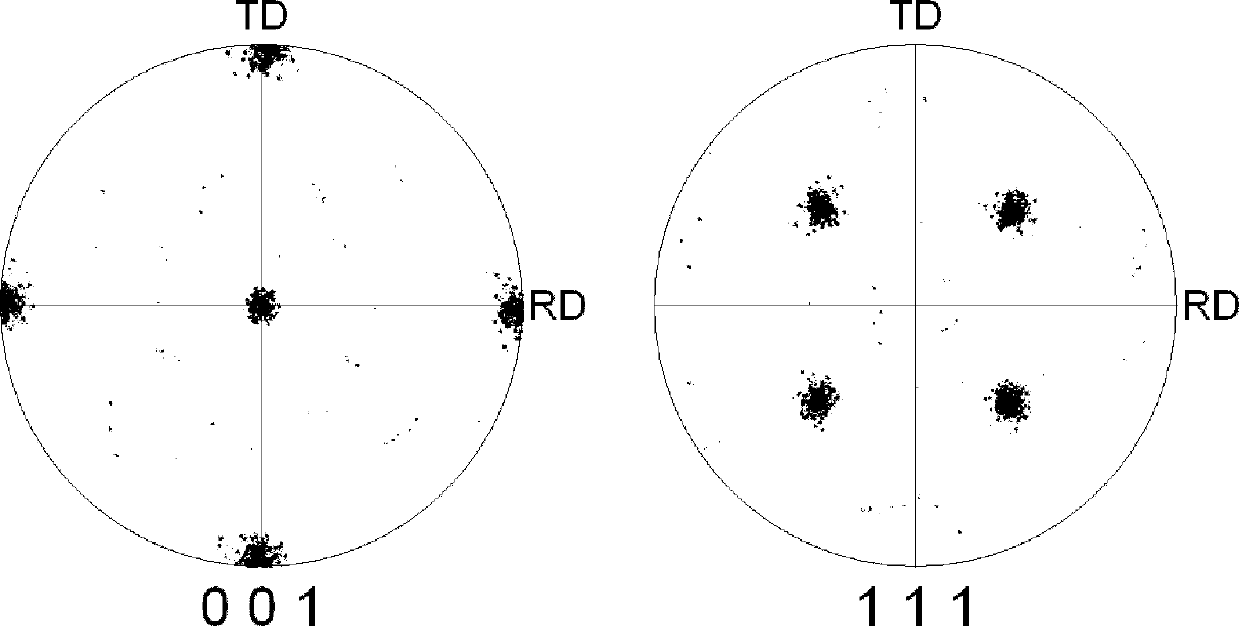Manufacturing process for non-magnetic Cu-base alloy basebands in strong cubic texture
A strong cubic texture, non-magnetic technology, applied in metal rolling and other directions, can solve the problems of baseband grain boundary quality characterization, hysteresis loss, etc.
- Summary
- Abstract
- Description
- Claims
- Application Information
AI Technical Summary
Problems solved by technology
Method used
Image
Examples
Embodiment 1
[0017] The electrolytic Cu and electrolytic Ni with a purity of 99.9% are mixed according to the weight of copper and nickel at 60:40, and the two raw materials are melted in an electromagnetic induction vacuum melting furnace to obtain Cu 60 Ni 40 Alloy initial ingot; then heat the alloy ingot at 850°C for 2 hours, then hot forge it into a 400mm, 30mm wide, and 20mm high billet, and then carry out hot rolling treatment. Rolling, the deformation of each pass is 10%, the total deformation is 30%, and finally wire-cut to obtain Cu with the dimensions of length, width and height respectively 20mm×15mm×10mm 60 Ni 40 Alloy ingots. Then it is subjected to a cold rolling treatment with a deformation amount of 5% per pass and a total deformation amount of 99%, to obtain an alloy base strip with a thickness of 100 μm. The cold-rolled base strip was placed in Ar / 4%H 2 Under the protection of mixed gas, a two-step annealing process was adopted. First, the temperature was raised to 55...
Embodiment 2
[0019] The electrolytic Cu and electrolytic Ni with a purity of 99.9% are mixed according to the weight of copper and nickel at 70:30, and the two raw materials are melted in an electromagnetic induction vacuum melting furnace to obtain Cu 70 Ni 30 Alloy initial ingot; then heat the alloy ingot at 850°C for 2 hours, then hot forge it into a 450mm, 30mm wide, and 15mm high ingot, and then carry out hot rolling treatment. Rolling, the pass deformation is 8%, the total deformation is 30%, and finally the wire cutting obtains Cu with the dimensions of length, width and height respectively 20mm×15mm×10mm 70 Ni 30 Alloy ingots. Then it is subjected to a cold rolling treatment with a deformation amount of 4% per pass and a total deformation amount of 99%, to obtain an alloy base strip with a thickness of 100 μm. The cold-rolled base strip was placed in Ar / 4%H 2 Under the protection of mixed gas, a two-step annealing process was adopted. First, the temperature was raised to 550°C ...
Embodiment 3
[0021] The electrolytic Cu and electrolytic Ni with a purity of 99.9% are mixed according to the weight of copper and nickel at 80:20, and the two raw materials are melted in an electromagnetic induction vacuum melting furnace to obtain Cu 80 Ni 20 Alloy initial ingot; then heat the alloy ingot at 850°C for 2 hours, then hot forge it into a 400mm, 33mm wide, and 17mm high ingot, and then carry out hot rolling treatment. Rolling, the deformation of each pass is 10%, the total deformation is 40%, and finally wire-cut to obtain Cu with the dimensions of length, width and height respectively 20mm×15mm×10mm 80 Ni 20 Alloy ingots. Then it is subjected to a cold rolling treatment with a deformation amount of 3% per pass and a total deformation amount of 99.2%, to obtain an alloy base strip with a thickness of 80 μm. The cold-rolled base strip was placed in Ar / 4%H 2 Under the protection of mixed gas, a two-step annealing process was adopted. First, the temperature was raised to 55...
PUM
| Property | Measurement | Unit |
|---|---|---|
| thickness | aaaaa | aaaaa |
| thickness | aaaaa | aaaaa |
Abstract
Description
Claims
Application Information
 Login to View More
Login to View More - R&D
- Intellectual Property
- Life Sciences
- Materials
- Tech Scout
- Unparalleled Data Quality
- Higher Quality Content
- 60% Fewer Hallucinations
Browse by: Latest US Patents, China's latest patents, Technical Efficacy Thesaurus, Application Domain, Technology Topic, Popular Technical Reports.
© 2025 PatSnap. All rights reserved.Legal|Privacy policy|Modern Slavery Act Transparency Statement|Sitemap|About US| Contact US: help@patsnap.com



